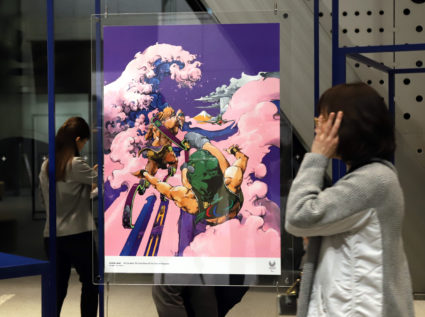
New posters for the 2020 Tokyo Olympics pay homage to Japanese art
It will be months before the world's best runners, swimmers and gymnasts take their marks at the 2020 Tokyo Games, but you can get a preview of Japan's artistic approach to promoting the global event now.
Twenty official posters for this year's competitions were unveiled this week, many sidestepping traditional Olympic imagery like flames, the five-ring logo or even athletes, opting instead for more conceptual designs that reflect Japan's visual culture, like calligraphy and manga.
The posters — 12 for the Summer Games in July and eight for the Paralympics the following month — were selected by a committee of Japanese designers and museum officials, among other cultural figures.

Among the notable departures from traditional Olympic imagery is contemporary artist Tomoko Konoike's "Wild Things – Hachilympic." Konoike's past work has often put nature and fantastical beasts at its center, including a crystalline six-legged wolf. Her Olympic poster gets close up to the textured, almost furry face of a young human-animal hybrid creature. In her description about the poster, Konoike said, "As animals, each human being grasps the world with totally different perceptions," suggesting that these differences are what unite us. "We see the world through our own umwelts. None are the same. No words are identical. No light is identical," she added.
The avant-garde nature of Konoike's poster is a marked shift from Olympic poster history, including what was created the last time Tokyo was the host city. For the 1964 Games, Tokyo's official poster was a simple reinterpretation of Japan's national flag. In Yusaku Kamekura's award-winning design, a big red circle sat above the interlocking Olympic rings on a white background.

For his 2020 "Space Kicker," painter Shinro Ohtake also employed simplified shapes in a collage that imagines an "Olympic scene far removed from Earth." An abstract, pink "god of games" appears to be kicking at a red ball. Olympiads are often depicted as godlike in past posters — a nod to the ancient Greek origins of the games — but not usually from scraps of colored paper.
Ohtake said his "Space Kicker" "spontaneously appeared" from where random scraps of paper landed in his studio after he had thrown them into the air.

Asao Tokolo designed this year's logo for the games, and his ring-like emblems are also featured on two posters. They are his homage to the designers of the 1964 Tokyo Games, fashioning geometric shapes into a circle meant to represent all the participating countries. But instead of the simplified red and white design of the past, Tokolo said he used "ai" (traditional Japanese indigo) as the dominating color for his posters because "Japanese indigo printing ink is a strong and beautiful color that stays true over time."

Graphic designer Daijiro Ohara's "flow line" continues to play with that thread of connection. The poster doesn't display a symbolic Olympic torch, but its many lines are meant to evoke the ceremonial movement of the flame when it travels through Japan's 47 prefectures — a rough outline of the nation's islands peaks through.

Manga artist Hirohiko Araki's "The Sky above The Great Wave off the Coast of Kanagawa" is a dynamic scene of Paralympians in motion. Inspired by Katsushika Hokusai's woodblock print masterpiece "The Great Wave," Araki said he "imagined the gods of sports descending on Japan from a sky filled with clouds resembling turbulent waves."

The poster selected from Naoki Urasawa, also a manga artist, looks like a page ripped from a black-and-white, Japanese comic book. Titled "Now it's your turn!," the poster captures the anticipation and excitement of the games.

Photographer Takashi Homma's poster does not feature any elite athletes in competition — and that's by design. Homma said he didn't think the Olympic Games "exclusively belong to select athletes." For "Tokyo Children," his photo of a boy "expressed the idea that the Games are a memorable beacon of hope that belongs to all people, both young and old."
Posters have been commissioned to promote the Olympics since 1912 in Stockholm. For that year's games, the official poster featured nude male athletes waving their country's flags, led by Sweden. According to the Olympic Studies Centre, which is part of the International Olympic Committee, the poster "caused shock," despite some strategically placed ribbons.
Other posters for the 2020 Games were designed by artist and illustrator Philippe Weisbecker, photographer Viviane Sassen and Turner Prize-winning painter Chris Ofili. The original posters will be on display at the Museum of Contemporary Art Tokyo until Feb. 16.

View more of the selected posters for the 2020 Games below:











Support Canvas
Sustain our coverage of culture, arts and literature.


















